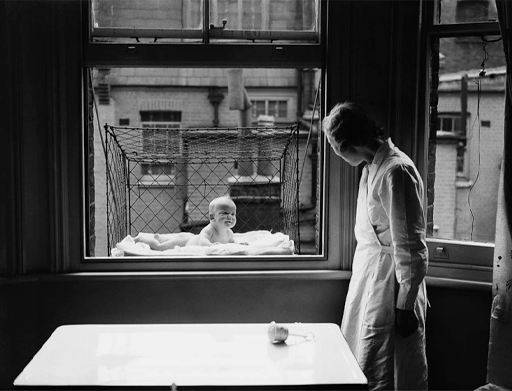Session 1: Taken for granted practices with young children and the outdoors
Introduction
Do you remember being outside when you were very little? Were you allowed to make mud pies? Perhaps you were fascinated by mini-beasts – or even fearful of them! Maybe you were left outside in your pram to sleep?
Whatever choices your parents and carers made to support your engagement with the outdoors, or nature, will depend very much on how old you are and your cultural and geographical background. Look for example at Figure 1: this is a photo of a baby cage – an invention from the early twentieth century to ensure that babies who lived in homes without gardens were able to access the outdoors. Even Eleanor Roosevelt, who was to become FLOTUS (the First Lady of the United States), revealed in her autobiography that she used one to let her baby get fresh air.
Can you imagine these being installed today? And if not – why would that be? You may have been really shocked to see this picture, a reaction which demonstrates how assumptions about what is good and right for young children are informed by the historical and cultural context.
You are going to look more closely at this idea of context in the very first session of this course which focuses particularly on the youngest age group, often called ‘Babies and Toddlers’ (birth to two years old). One of the ways you will do this is by first looking at some important voices from history who spoke about young children’s engagement with the outdoors. Then you will examine cultural differences to approaches with young children such as those in Scandinavia and New Zealand. You will think about what can be discovered in research literature about different practices and about different benefits to young children.
To begin with, take a few minutes to listen to the following audio in which Joanne Josephidou, Session 1 author, introduces the content.
Transcript
JOANNE JOSEPHIDOU: Approximately, 385,000 babies are born every single day. Each will have their own trajectory dictated predominantly by where in the world they are born, who their parents are, and what access they have to early childhood education and care.
When a baby is born, there is often a wealth of friends and family who are ready to offer advice and guidance to the new parent on the best way to care for the young child. That advice is informed by family practices and society's expectations.
Once the child enters a more formal care setting, advice continues to abound. It is often dictated by policy, but can still be informed by books, family practices, and cultural expectations. So it's important that we continually challenge our own assumptions about what is best for babies and toddlers, and that we know where our beliefs about best practices come from.
In this very first session, this is what we invite you to do by considering both historical practices concerning very young children and the outdoors and different practices that are happening in diverse, geographical, and cultural contexts. For example, you will be able to hear from Dr Maria Cooper from the University of Auckland, along with Shirlene, an early childhood education leader in New Zealand, discussing some of the cultural practices which inform young children's engagement with the outdoors and nature in their context.
By the end of this session, you should be able to:
- list some key voices from the past who spoke about young children’s engagement with the outdoors and nature
- briefly outline some cultural practices of young children’s engagement with the outdoors and nature
- list some of the messages from research about why being outdoors benefits young children and about current practices with young children in the outdoors.
The Open University would really appreciate a few minutes of your time to tell us about yourself and your expectations for the course before you begin, in our optional start-of-course survey [Tip: hold Ctrl and click a link to open it in a new tab. (Hide tip)] . Participation will be completely confidential and we will not pass on your details to others.

